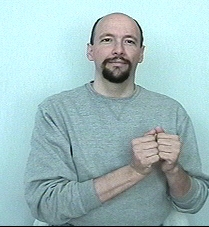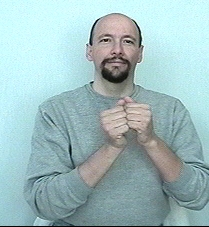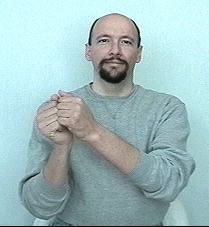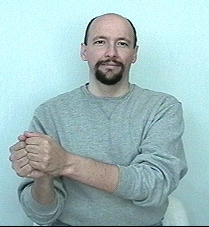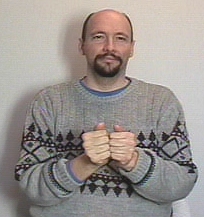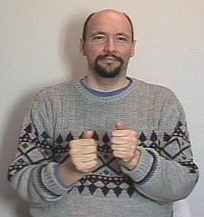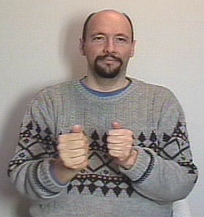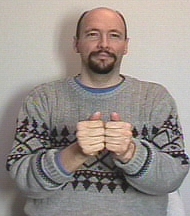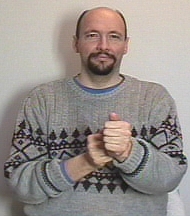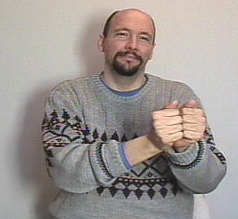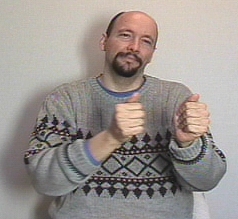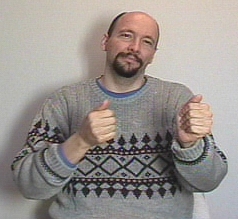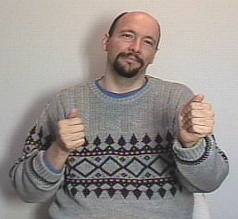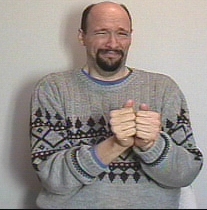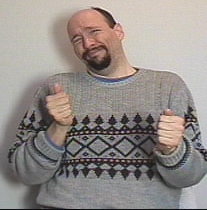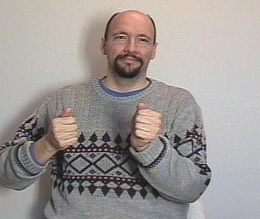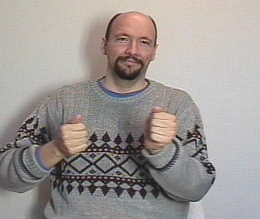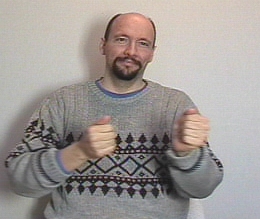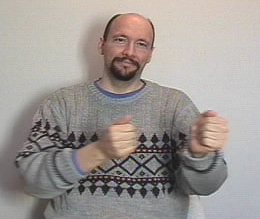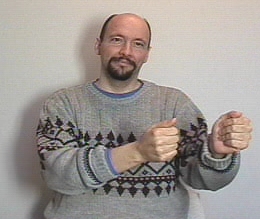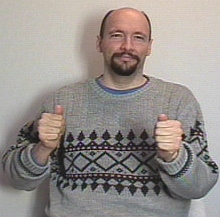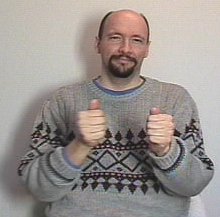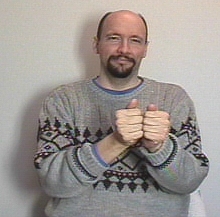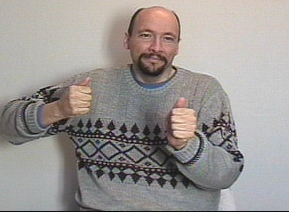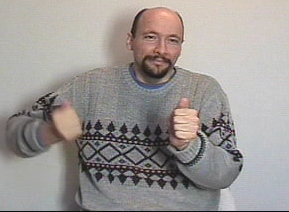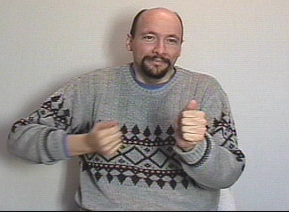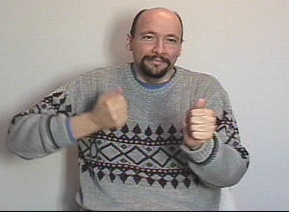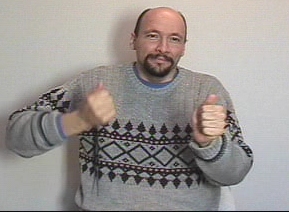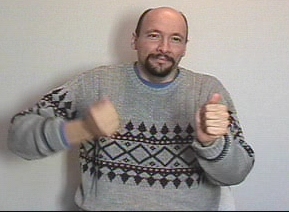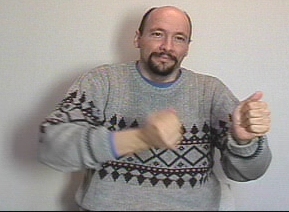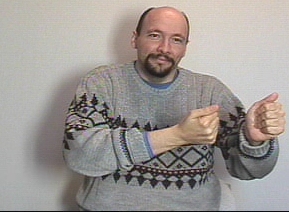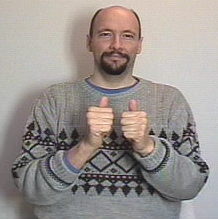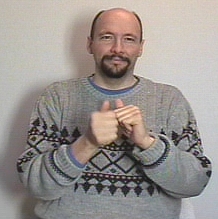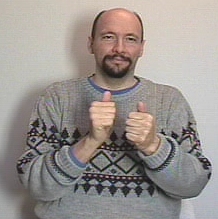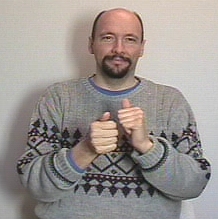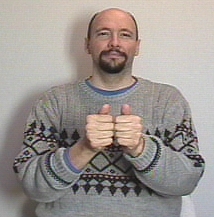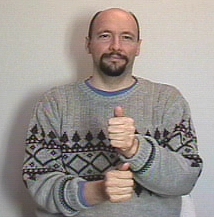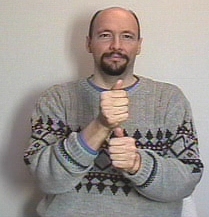American Sign Language: "with" (advanced
discussion)
WITH:
The sign for "with" is the basis for many other signs including:
WITH / ACCOMPANY / AHEAD / BEHIND / FOLLOW / CATCH-UP / CHASE / RACE-COMPETE / SUBORDINATE / SUPERIOR / GO-STEADY
See below for more info.
Dear Dr. Bill,
If I'm letting someone know that I am learning sign using the internet...would I sign: "I LEARN SIGN WITH INTERNET"? Or does WITH convey more of a 'together' concept? Should I instead sign: I LEARN SIGN, USE INTERNET?
- Alex
Dear Alex,
No. The sign WITH is not used to mean "via" as in, "I'm learning sign via the internet."
Actually you do not need the concept of "with" or "via" in this sentence. The sign "INTERNET" also means "online."
Thus you could sign:
"I LEARN SIGN INTERNET I" Which is a way of saying, "I am learning sign language online."
In English you wouldn't dream of saying, "I am learning sign language with online" would you?
Or if it is a dialog it might go like this:
Signer A: "YOU LEARN SIGN HOW?"
Signer B: "INTERNET"
- Dr. Bill
The sign for "WITH" is made by forming the letter "a" with both hands. Place both your hands together, palms facing.
WITH:
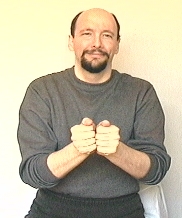
If you hold the "A" hands together and then make a sweeping horizontal circle (while keeping them together--looks like you are stirring a witch's brew on Halloween) it means "TOGETHER."
TOGETHER:
Suppose you want to sign "Go with?" Use this sign for "accompany." It can mean, "Come along." If you sign "WANT ACCOMPANY?" after indicating that you are going to the store, that would mean that you are asking the person if he or she wants to go with you to the store. You don't need a separate sign for "GO."
ACCOMPANY:
If you start with them together then move the right hand in front of the left hand, it means "ahead" or "ahead of."
AHEAD:
BEHIND ("in back of")
If you start with them together then move the right hand behind the left hand, it means "BEHIND."
FALL-BEHIND:
Hold your "A" hands together, out away from your body, a bit off to your non-dominant side. Then pull your dominant hand backward (away from the non-dominant hand). If you do a quick simple movement it means "behind schedule" or "not up with the others." If you do a slower movement and "waggle" it a bit you can change the meaning into "falling behind." You might even see the mouth opened a bit and the tongue over the lower teeth (which is what a person who is tired and panting looks like) used to emphasize "not being able to keep up."
AVOID:
If you start with both the left hand and the right hand out from your body (slightly off to the left) and then pull right hand back toward the right side of your body it means "FALL-BEHIND" (Or it can also mean AVOID.)
FOLLOW:
If you start with the left hand a little bit ahead and then move them both forward and to the left in a smooth steady motion it means "FOLLOW." The dominant hand doesn't "catch up" to the non-dominant hand. It just follows it.
CATCH-UP:
If you start with the left hand farther ahead and the right hand back near your body then move the right hand up to the left hand it means "CATCH-UP."
If you start with the left hand a little bit ahead and then move the left hand forward and to the left in a smooth steady motion while moving the right hand forward and to the left in a spiraling motion it means "chase."
CHASE:
If you alternate moving your hands forward and back (so that one is farther out than the other) it can mean race or competition. (This is not used for things like a person's heritage. For that kind of race, just spell R-A-C-E.)
COMPETE:
Animation: RACE / compete
If you start with them together then move the right hand under the left hand, it means "subordinate" as in: lower in rank / an object stacked under another object, underling.
SUBORDINATE:
SUPERIOR: (above in rank, on top of, placed over)
If you hold the "A" hands together and then move them forward and back about three inches using a double motion it means "GO-STEADY" (as in dating).
GO-STEADY:
Also see: WITHOUT
Also see: PASS
You can learn
sign language
(ASL) online at American Sign Language University ™
Lifeprint.com © Dr. William Vicars

